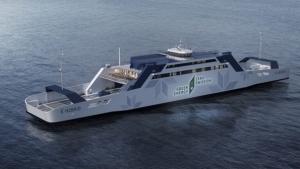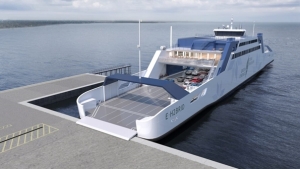Estonian fleet – Electric and Hydrogen Revolution

 By Marek Grzybowski
By Marek Grzybowski
Estonia has focused on ecology and announced that the newest ferry will start introducing a new generation of energy-saving ships into operation. A ferry with electric and hydrogen propulsion will initially be introduced on the Virtsu-Kuivatu connection. To start, it obtained EUR 40 million from the European Modernization Fund and revenues from CO2 emissions trading.
January 17, 2024 is the deadline for submitting offers for the construction of the ship. There is an opportunity for Polish shipyards, such as CRIST, with experience in the production of innovative ships. CRIST is the coordinator of the zero-emission ship production hub as part of a project implemented with partners from Norway and Croatia. There is also an opportunity for companies from the ASE Technology Group and others to take part in the project to produce shore-based energy charging and storage installations, and perhaps also hydrogen bunkering stations.
Hydrogen ferry for the Estonian fleet
This will be another new ferry introduced to the Estonian fleet. But the first one so innovative in terms of hull and drive design. It is emphasized that this will be a unique structure in the entire region due to the drive used. The ferry will be battery-powered. But its propulsion system will also be able to ensure that it runs on hydrogen fuel throughout the entire route.
And most importantly, the operation of the gym will not emit noise and vibration. The ferry has been designed to be used on the Triigi-Soru route, connecting the islands of Saaremaa and Hiiumaa. Initially, it will be deployed as the main passenger car ferry on the route from Virtsu on the mainland to Kuivastu on the island of Muhu.
According to Andres Laasma, CEO of the Estonian State Fleet, much attention was paid to energy efficiency when designing the new ferry.
– What makes this ferry unique is the way it uses green energy, as well as energy storage and the technology of using it to power electrical devices – says Laasma.
The ship will charge electricity during its stay at the quay in Virtsu. If hydrogen fuel is used, bunkering will likely also take place in the same port. The ferry’s hull will also allow the ship to sail in Estonian ice conditions using a battery-powered drive.
– Thanks to the latest technologies and innovative hull design, the energy consumption of the new ferry will be almost 20% lower compared to the previous generation of ferries – announces Laasma.
Scientific local content – TalTech Estonian Maritime Academy
The ferry concept was developed with Finnish scientists from TalTech Merakadeemia. During the design process, great attention was paid to creating a prototype of a maritime digital twin.
– The digital twin helps analyze the designer’s work by analyzing digital data and comparing it with historical data. The digital twin was used to optimize [propulsion and structure – MG] – explained Walentin Bratkow from TalTech Estonian Maritime Academy, Project Manager of the electric-hydrogen ferry.
The new ferry is equipped with automatic navigation and decision support. This will allow the ship to sail between ports in fully autonomous mode.
– This does not mean that the ferry will sail without a crew. Various types of work, such as navigation, including docking and mooring, shore-side charging, engine room work, car deck operations and customer service, can be fully self-service, Bratkow explained to ERR.ee.
In the preparatory phase of the contract and project development, cooperation was carried out with Deltamarin. The company also assisted the buyer in developing a conceptual design. The idea was to check what parameters the ferry must have in order to best use it to service Estonian routes in the long term.
The ferry concept was also checked in terms of requirements for vessels by Lloyd’s Register classifiers. The classification society approved the conceptual design in late November 2023.
– LR is honored to have acted as a trusted advisor on this project with the Estonian State Fleet to provide the Estonian government with a new hydrogen battery-powered ferry on the Virtsu-Kuivastu and Rohuküla-Heltermaa routes. This ferry will not only help advance the transition to low- and zero-emission ships, but will also provide better connectivity between Estonia and its largest islands, emphasized Patrick Wrede, key account manager at LR, reports ERR.ee.

Time for the shipyard
The invitation to submit offers for the construction of the ferry was announced on December 11, 2023 by the Estonian State Fleet, the state administration responsible for the development and management of Estonian ships.
The deadline for submitting offers for the construction and design of the vessel is January 17, 2024. The ferry operation on the Virtsu–Kuivastu route is scheduled to begin on October 1, 2026.
Estonian Climate Minister Kristen Michal said that the purchase of a new ferry is a good example of how to contribute to economic development while protecting nature.
– Further development of ferry technology is necessary to improve the quality of connections for people and tourists visiting the islands. By using energy efficiently, we as a country and customers can make more trips in a more nature-respecting way for every euro, said Kristen Michal.
In October 2023, Hamburgische Schiffbau-Versuchsanstalt GmbH (HSVA) was commissioned to investigate the ferry’s navigation capabilities in ice-covered waters. HSVA concluded that the ferry concept meets high energy efficiency requirements. The study showed that the shuttle was able to crush thin ice at a constant speed. During the test, it was found that the ferry achieved the minimum speed in ice swimming conditions for ice class IA.
– The design allows for work in even more difficult ice conditions, including: drifting and ice breaking – said Nils Reimer, head of the Arctic Technology department at HSVA.
The new ferry will accommodate approximately 1,000 meters of loading line for cars. This is about 20% more than the previous generation ferries. The ferry has space to carry up to 700 passengers.
The estimated cost of the contract is approximately EUR 40 million. The construction of the ship will be financed by the European Modernization Fund and revenues from CO2 emissions trading.
In 2020, Estonia modernized the Tõll ferry. It has been rebuilt to hybrid mode. The ship began service on the Virtsu-Kuivastu ferry line between Muhu and mainland Estonia as the country’s first hybrid passenger ship.
